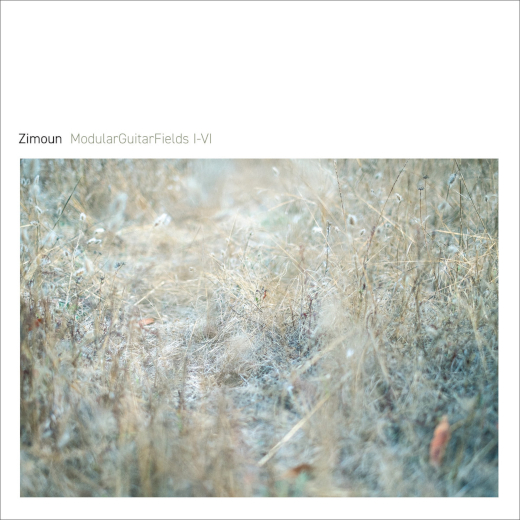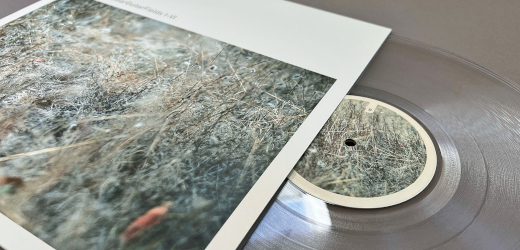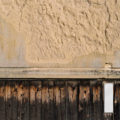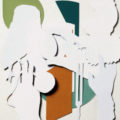Modular Guitar Fields I-VI encompasses the expansive quality of dark ambient and the fuzz here is warm, analog, and rich.

Long sustained tones interrupted by micro-glitches
It starts with the fizz of static, like a can of pop being opened, but this isn’t pop music. Maybe it is more like the spark inside an old transistor radio, coming back to life. From within its speaker emerges the staccato pulses of detuned strings vibrating into the atmosphere. When I first stumbled upon this album while digging through Bandcamp’s endless crates, I was immediately excited. When I tuned in, I was hooked. Guitar drone and guitar ambient have become a favorite little niche area of music for me to explore in the past few years. It interrelates to another musical obsession of mine over the same time period: American Primitive guitar music, the soundworlds of John Fahey, Robbie Basho and others who have carved out a new-old vision of minimalist fingerpicking.
Guitar based ambient and instrumental American Primitive go well together because they both reveal expansive, yet intricate, spaces where the imagination of the listener can relax and flourish. Relaxation is a key ingredient for me anymore in music, though I still love all the pulse pounding stuff and material with hyperkinetic beats. The world outside often seems hyperkinetic enough, and sensory overload all too real, so I seek regular refuge inside the ambient bubble. This means I am also ever on a quest to find nourishing sounds that can inspire, while at the same time, relieve tension. This doesn’t mean they need to be New Age or on the light-edged side of ethereal music. It can be music with a darkened, sepia toned tinge. Warm and glowing distortion is also welcome. I found what I was looking for on this album from the Bern, Switzerland based Zimoun.
Modular Guitar Fields I-VI encompasses the expansive quality of dark ambient and the fuzz here is warm, analog, and rich. Zimoun captured the tones of a Tenor Baritone Guitar processed through various elements of a Modular Synth setup, that was then fed into a 1960s Magnatone Amp. I don’t know for sure, but I’m guessing this model is a tube amplifier, giving this album its distinct warmth, even as it swirls in a slight dusting of melancholy. Amp modeling has become very popular in music software, but the real thing can’t be beat.
The gentle flutter of tones and notes erupting through the processing chain ::
Here the emphasis of the music is not on the virtuosity of a guitar player, as it often is with the fingerpickers whom I admire, or with the metalheads and punkers who know how to shred. Zimoun focuses on the gentle flutter of tones and notes erupting through the processing chain.
The emphasis here is on long sustained tones interrupted by micro-glitches and slight changes of texture. The experience is primarily a timbral one. There is a grain to the recording, like the grain found in old wood. The gnarled whorls and patterns feel so organic, you forget the music you are listening is in part electronic.
These compositions fill up the listening space, and become part of the room, conferring on it a sense of dark majesty. The term “sound sculpture” sometimes feels a bit cliché when talking about ambient music. Yet with these drones it is totally spot on. That makes sense when you look at the other work of Zimoun, work I was not at all familiar with before hearing this release. Though Zimoun releases plenty of recordings, most of them are based on his work as an installation artist.
Zimoun uses the principles of mechanics and rotation and oscillation to make physical objects vibrate and produce sound. He uses a mixture of things found in everyday life coupled with some from industry, like motors, cable and welding wire. He builds small apparatuses, and will often use many of them in one work, to create an orchestra of mechanical sculptures that fill a space with their orchestrated song as everything is set into motion.
This album however is similar to works by other artists who have used “prepared guitar.” Keith Fullerton Whitman had also previously combined guitar with his modular synthesizers. Yet with the inclusion of the word “field” in the album title Zimoun suggests the overriding spatial qualities of the sound produced by the object. It is a field I will be happy to spend more time in, basking in the combined glow of guitar, synth, amplifier.
ModularGuitarFields I-VI is available on 12k. [Bandcamp | Site]




















![Luke’s Anger :: Ceiling Walker EP (Love Love) — [concise]](https://igloomag.com/wp/wp-content/uploads/2025/04/lukes-anger-ceiling-walker-vinyl_feat-75x75.jpg)

![Ndorfik & madebyitself :: Solos EP (People Can Listen) — [concise]](https://igloomag.com/wp/wp-content/uploads/2025/04/ndorfik-madebyitself-solos_feat-75x75.jpg)





